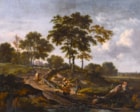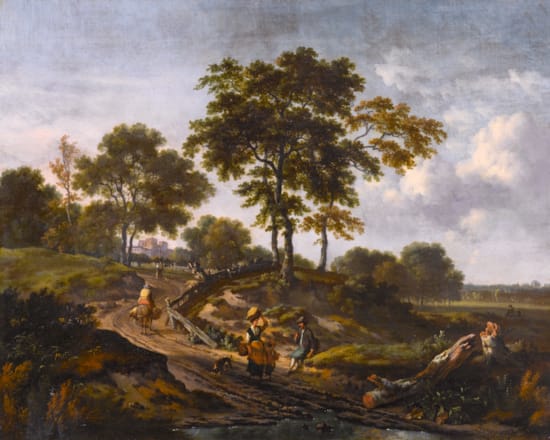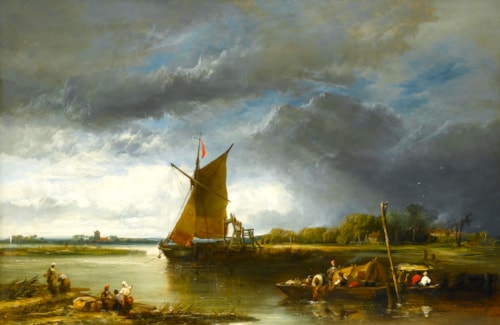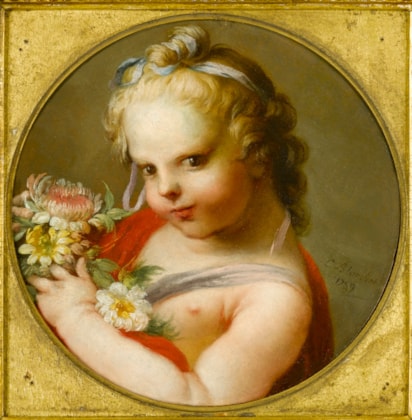an Wijnants
(Haarlem 1635 - Amsterdam 1684)
A Landscape with Peasants Conversing on a Countryside Path
signed and dated ‘J. Wijnants/1667’ (lower right)
oil on canvas
49.5 x 62 cm (19½ x 24⅜ in)
In A Landscape with Peasants Conversing on a Countryside Path, Jan Wijnants has painted a scene which evokes the sandy landscape around his native Haarlem. From a pool of water in the foreground, a path winds its way up a gentle slope towards the edge of a town visible in the background, this recession accentuated by the deep track marks that a cart has left in the soft terrain. In the foreground a woman laden with goods walks along this path, accompanied by a small dog and her son, who is clinging to her skirt. As they walk, mother and child turn to acknowledge a traveller who is taking a break on the side of the road. Further along the path a man can be seen riding a pack-mule, and beyond him, a couple walk their dog. In contrast, the right-hand side of the painting is sparsely populated by the faint depiction of two figures, their isolated presence emphasising the vastness of the extensive landscape, which melts away into the distance.
On the left-hand side of the painting, Wijnants has depicted a soft sandy terrain, which is covered by a thin layer of grass. These dunes evoke the landscape around Haarlem, recalling Wijnants’ volume of work that follows in the tradition of dune painting established by artists such as Pieter de Molijn (1595-1661), Philips Wouwerman (1619-1668) and Jacob van Ruisdael (1628/9-1682). In the foreground there are detailed depictions of various shrubs with groves of trees dotted throughout the painting. The scene is lit by a soft light, which reflects off the still water of the puddle, with a considerable portion of the canvas being devoted to a study of the sky and the shifting weather.
The present painting is typical of the artist’s work, echoed in its comparison with the Hermitage’s Landscape with a Dune. Although the landscape in the Hermitage painting does not appear to be as fertile as that in the present work, both paintings share many characteristics, not least the sandy terrain, which provides the setting for a large proportion of Wijnants’ later work. In both paintings a path meanders its way from a body of water in the foreground, through the landscape, towards some distant buildings. A smattering of peasants animate both works,¹ with a sense of open space being created in one half of the picture, balanced by a more focused and detailed study of natural features in the other. Both paintings also reflect Wijnants’ interest in the shifting and varied nature of the sky, and considerable space on the canvas is given over to its depiction. Also noteworthy is the inclusion in both works of the snapped tree trunk in the foreground, a motif that recurred throughout Wijnants’ oeuvre, echoing the similar use of such a motif in the work of van Ruisdael.
Wijnants probably started to paint shortly after 1650, and his earliest works are characterised by his prominent use of brick farm buildings and cottages, as well as the numerous wildfowl which occupy the foregrounds. However, as his career progressed, the buildings in his work became considerably smaller and were relegated to the middle-ground. In 1660, he moved from Haarlem to Amsterdam, and it was around this period that his paintings began to evoke the landscape surrounding Haarlem. This middle period of his career, from about 1660 until 1675, during which time the present work was painted, can be considered his most important, and is characterised by a focus on the landscape. Wijnants spent the rest of his life working in Amsterdam, and also ran an inn in an attempt to supplement his income as he was constantly falling into debt. Wijnants’ paintings were to influence numerous eighteenth and nineteenth-century artists, including François Boucher (1703-1770) and Thomas Gainsborough (1727-1788), in addition to his own pupils, who included Adriaen van de Velde (1636-1672).
¹ In Landscape with a Dune the figures were painted by Johann Lingelbach (1622-1674). The staffage in Wijnants’ landscapes was frequently painted by other artists.
In the family collection of the previous owner since the early twentieth century.
In A Landscape with Peasants Conversing on a Countryside Path, Jan Wijnants has painted a scene which evokes the sandy landscape around his native Haarlem. From a pool of water in the foreground, a path winds its way up a gentle slope towards the edge of a town visible in the background, this recession accentuated by the deep track marks that a cart has left in the soft terrain. In the foreground a woman laden with goods walks along this path, accompanied by a small dog and her son, who is clinging to her skirt. As they walk, mother and child turn to acknowledge a traveller who is taking a break on the side of the road. Further along the path a man can be seen riding a pack-mule, and beyond him, a couple walk their dog. In contrast, the right-hand side of the painting is sparsely populated by the faint depiction of two figures, their isolated presence emphasising the vastness of the extensive landscape, which melts away into the distance.
On the left-hand side of the painting, Wijnants has depicted a soft sandy terrain, which is covered by a thin layer of grass. These dunes evoke the landscape around Haarlem, recalling Wijnants’ volume of work that follows in the tradition of dune painting established by artists such as Pieter de Molijn (1595-1661), Philips Wouwerman (1619-1668) and Jacob van Ruisdael (1628/9-1682). In the foreground there are detailed depictions of various shrubs with groves of trees dotted throughout the painting. The scene is lit by a soft light, which reflects off the still water of the puddle, with a considerable portion of the canvas being devoted to a study of the sky and the shifting weather.
The present painting is typical of the artist’s work, echoed in its comparison with the Hermitage’s Landscape with a Dune. Although the landscape in the Hermitage painting does not appear to be as fertile as that in the present work, both paintings share many characteristics, not least the sandy terrain, which provides the setting for a large proportion of Wijnants’ later work. In both paintings a path meanders its way from a body of water in the foreground, through the landscape, towards some distant buildings. A smattering of peasants animate both works,¹ with a sense of open space being created in one half of the picture, balanced by a more focused and detailed study of natural features in the other. Both paintings also reflect Wijnants’ interest in the shifting and varied nature of the sky, and considerable space on the canvas is given over to its depiction. Also noteworthy is the inclusion in both works of the snapped tree trunk in the foreground, a motif that recurred throughout Wijnants’ oeuvre, echoing the similar use of such a motif in the work of van Ruisdael.
Wijnants probably started to paint shortly after 1650, and his earliest works are characterised by his prominent use of brick farm buildings and cottages, as well as the numerous wildfowl which occupy the foregrounds. However, as his career progressed, the buildings in his work became considerably smaller and were relegated to the middle-ground. In 1660, he moved from Haarlem to Amsterdam, and it was around this period that his paintings began to evoke the landscape surrounding Haarlem. This middle period of his career, from about 1660 until 1675, during which time the present work was painted, can be considered his most important, and is characterised by a focus on the landscape. Wijnants spent the rest of his life working in Amsterdam, and also ran an inn in an attempt to supplement his income as he was constantly falling into debt. Wijnants’ paintings were to influence numerous eighteenth and nineteenth-century artists, including François Boucher (1703-1770) and Thomas Gainsborough (1727-1788), in addition to his own pupils, who included Adriaen van de Velde (1636-1672).
¹ In Landscape with a Dune the figures were painted by Johann Lingelbach (1622-1674). The staffage in Wijnants’ landscapes was frequently painted by other artists.
In the family collection of the previous owner since the early twentieth century.




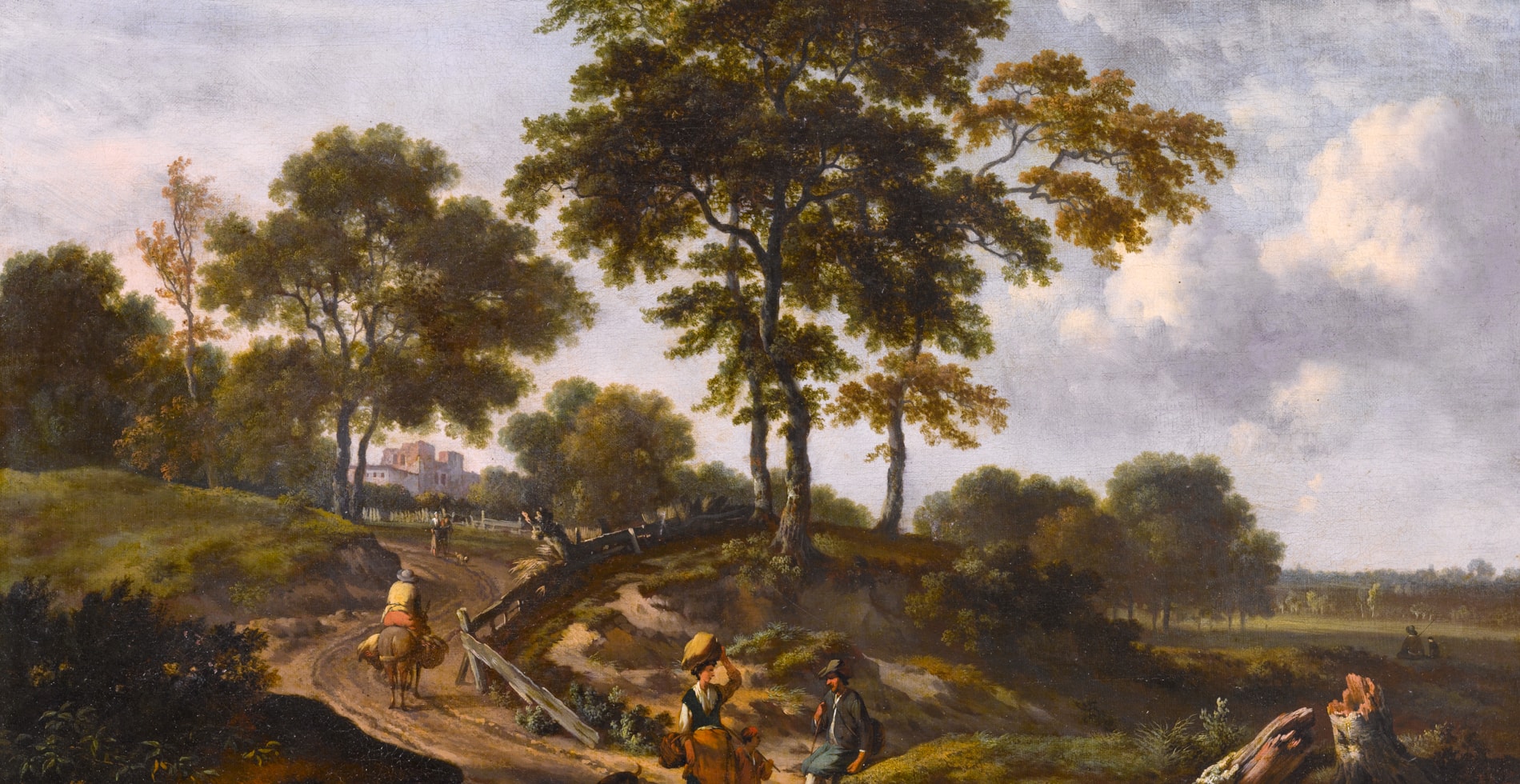
 contact
contact contact
contact +44 20 7313 8040
+44 20 7313 8040